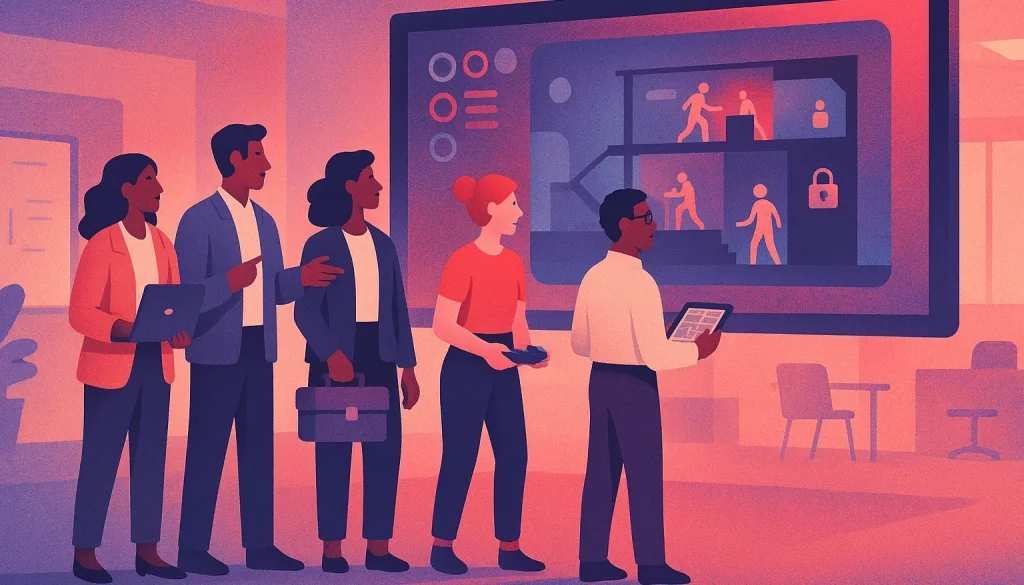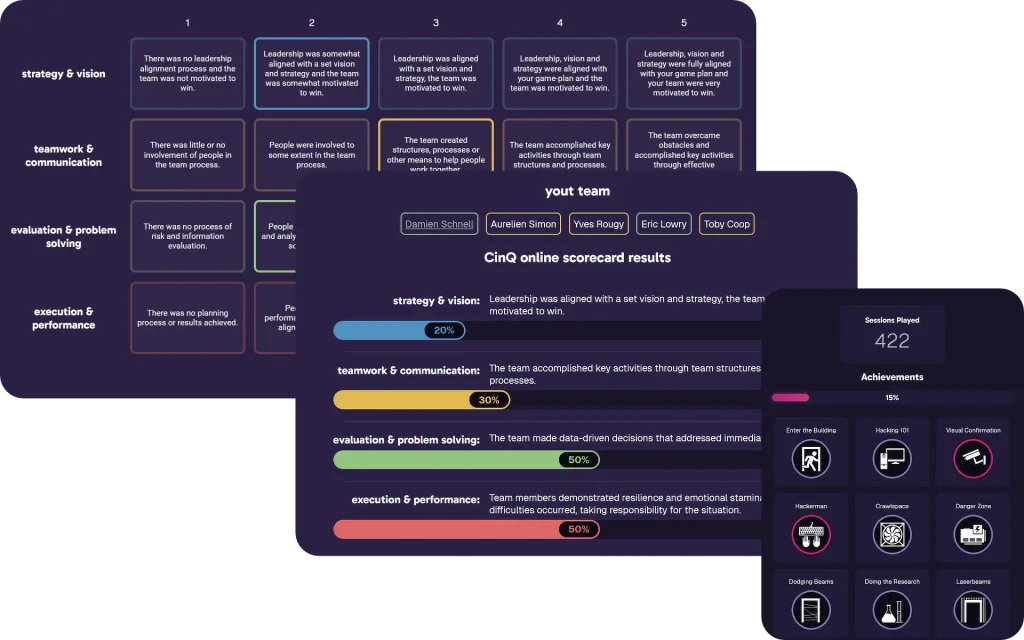Real decisions, real consequences
CinQ missions demand action in real time. Teams navigate ambiguity, adapt under constraint, and make shared decisions that shape the outcome.

CinQ's pedagogy is the design engine behind the simulation and coaching. It defines how challenges unfold, how decisions emerge, and how feedback drives performance.
Every element is structured to reveal behavior, support alignment, and build capability, in real conditions.

Teams now operate in high-speed, interdependent environments where success depends on real-time coordination, decision-making, and adaptability with AI in the loop.
CinQ is architected to require collaboration: progress depends on how teams align, act, and decide together. The simulation functions as a behavioral capability engine, reinforcing coordination through shared challenges, surfacing team dynamics, and integrating AI as an active participant in every decision.
![[Bloom's Taxonomy / the Learning Pyramid]
Bloom's taxonomy (orders of thinking, lowest to highest): remember, understand, apply, analyze, evaluate, create
Learning pyramid (average retention rates): lecture 5%, reading 10%, audiovisual 20%, demonstration 30%, discussion group 50%, practice by doing 80%, teach others 90%.](/images/charts/learning-pyramid-sm.svg)
![[Bloom's Taxonomy / the Learning Pyramid]
Bloom's taxonomy (orders of thinking, lowest to highest): remember, understand, apply, analyze, evaluate, create
Learning pyramid (average retention rates): lecture 5%, reading 10%, audiovisual 20%, demonstration 30%, discussion group 50%, practice by doing 80%, teach others 90%.](/images/charts/learning-pyramid.svg)
![[Bloom's Taxonomy / the Learning Pyramid]
Bloom's taxonomy (orders of thinking, lowest to highest): remember, understand, apply, analyze, evaluate, create
Learning pyramid (average retention rates): lecture 5%, reading 10%, audiovisual 20%, demonstration 30%, discussion group 50%, practice by doing 80%, teach others 90%.](/images/charts/learning-pyramid-sm.svg)
![[Bloom's Taxonomy / the Learning Pyramid]
Bloom's taxonomy (orders of thinking, lowest to highest): remember, understand, apply, analyze, evaluate, create
Learning pyramid (average retention rates): lecture 5%, reading 10%, audiovisual 20%, demonstration 30%, discussion group 50%, practice by doing 80%, teach others 90%.](/images/charts/learning-pyramid.svg)
Built from the ground up for capability activation, CinQ integrates principles from team psychology, human-AI teaming, decision-making under complexity, and higher-order learning.
CinQ operates as a behavioral system engineered to make ambiguity, consequence, and alignment part of the learning process itself. For this, it draws on:
Team psychology and shared cognition
Decision-making in fast, high-context environments
Human-AI alignment and teaming
Bloom's taxonomy of applied thinking
The learning pyramid (retention through action)
CinQ missions demand action in real time. Teams navigate ambiguity, adapt under constraint, and make shared decisions that shape the outcome.
Every mission is built to mirror real execution dynamics: incomplete information, shared roles, high stakes, and competing priorities.
Facilitators reinforce learning through nudges, inquiry, and live feedback. Growth comes from reflection in motion, not post-hoc explanation.
With over 40 missions across 11 chapters, CinQ enables teams to operationalize core behaviors through deliberate practice and adaptive scenarios.
CinQ is benchmarked against 7 dimensions of behavioral fidelity; conditions that define how people operate under real-world complexity, coordination, and AI integration.
Each dimension reflects the operating environment teams now face: ambiguous context, asymmetric roles, shared timelines, and intelligent systems in the loop.
| behavioral fidelity dimension | benchmark |
|---|---|
| Environment | Realism drives transferable behavior under complexity |
| Decision pressure | Time-bound decisions reveal true operating patterns |
| Role complexity | Asymmetric roles require cross-functional alignment |
| Team dependency | Performance emerges from synchronized execution |
| Required adaptability | Unplanned events test agility and responsiveness |
| AI collaboration | Trains coordination with intelligent systems in shared tasks |
| Behavioral feedback | Enables in-situation course correction and growth |
CinQ is built on foundational research into multiplayer environments, leadership behavior, and team performance in dynamic execution conditions.
These studies shape CinQ's structure, activating real behavior through coordination, constraint, and consequence.
IBM & Seriosity (2007)
This study identified how multiplayer games mirror enterprise challenges:
Decisions made under compressed timelines
Team-based, distributed coordination
Role clarity and observable consequences
Leadership emerging through action, not assignment
Seriosity (2007)
Mapping in-game behavior to the Sloan Leadership Model (sensemaking, relating, visioning, inventing) showed multiplayer systems activate these leadership functions:
Team learning under shifting conditions
Feedback-rich, action-based decision cycles
Rotating and shared leadership
Improvisation in high-context, constrained environments
CinQ integrates these insights directly into its design:
The 360° scorecard reflects Sloan leadership dimensions
Mission structures create constraint, consequence, and collaboration
The AI teammate and coaching tools support continuous alignment
Each simulation activates real decision dynamics, not hypotheticals

Modern organizations face a growing execution gap: teams must operate in fast-changing, interdependent, and AI-integrated environments; yet most capability systems aren't built for those conditions.
CinQ closes that gap by delivering:
Performance visibility under real execution dynamics
Capability systems grounded in validated behavioral research
Measurable outcomes from structured, team-based coordination
An integrated environment for observing, coaching, and scaling behavior
CinQ enables leaders to activate real team performance under the same operational demands that now define success.
![[Graph]
[Sections]
Apathy (low skill, low challenge): Training that avoids challenge leads to stagnation and minimal skill development.
Boredom (high skill, low challenge): Traditional training emphasizes passive knowledge delivery and recall, with little focus on real skill development.
Anxiety (low skill, high challenge): CinQ surfaces capability gaps through real execution demands—where challenge meets interdependence.
Flow (high skill, high challenge): CinQ builds decision-making, coordination, and adaptability in live, AI-integrated conditions.
[Annotations]
Critical path: From average skill and low challenge, to high skill and high challenge.
Important (lower skill half of the quadrant): Low-challenge environments limit behavioral growth and coordination.](/images/charts/critical-flow-sm.svg)
![[Graph]
[Sections]
Apathy (low skill, low challenge): Training that avoids challenge leads to stagnation and minimal skill development.
Boredom (high skill, low challenge): Traditional training emphasizes passive knowledge delivery and recall, with little focus on real skill development.
Anxiety (low skill, high challenge): CinQ surfaces capability gaps through real execution demands—where challenge meets interdependence.
Flow (high skill, high challenge): CinQ builds decision-making, coordination, and adaptability in live, AI-integrated conditions.
[Annotations]
Critical path: From average skill and low challenge, to high skill and high challenge.
Important (lower skill half of the quadrant): Low-challenge environments limit behavioral growth and coordination.](/images/charts/critical-flow.svg)
Too much training is built for comfort, even though without pressure and interdependence, there's no transformation.
CinQ is designed to push teams into the "flow channel", a proven learning zone between boredom and anxiety, where real growth happens.
It is a calibrated challenge with live feedback and behavioral consequence. It is built to shift how people lead, adapt, and perform under pressure.

Every CinQ mission includes an embedded AI teammate designed to simulate real collaboration between humans and intelligent systems in live decision environments.
This AI agent is fully mission-aware and interacts as part of the team. It contributes data, suggestions, and insight, forcing teams to evaluate, adapt, and align in real time.
Each session builds one of the most critical execution capabilities:
Integrating AI input into shared decisions
Role coordination
Team alignment under dynamic conditions

CinQ has been deployed across global organizations, engineering environments, competitive teams, and transformation programs, where execution, adaptability, and team performance are critical.
It's used by:
Cross-functional engineering and operations teams
Enterprise sales and supply chain teams
Esports professionals and high-stakes performers
HR, tech, and leadership development teams driving change
From executives to first-line managers, CinQ helps teams see how they perform and then build the capabilities to operate better, together.

CinQ sessions are structured to turn team behavior into measurable capability by surfacing how teams operate under dynamic, interdependent, AI-enabled conditions.
Each session is:
Observed in real time through structured scorecards
Debriefed with targeted coaching and behavioral data
Reviewed to support reflection and iterative learning
Scored across leadership, communication, adaptability, and team execution
Analyzed for AI collaboration patterns, alignment behavior, and decision integration
This enables teams to translate observable behavior into repeatable execution.
This full-length simulation walkthrough gives a direct view into the mechanics that power CinQ: mission dynamics, real-time coordination, and behavioral coaching.
You'll see how CinQ activates execution-ready capabilities under the same high-context, AI-integrated conditions modern teams face every day.
Preview how CinQ builds adaptability, collaboration, and decision-making under dynamic, interdependent conditions
Understand the system architecture: role design, challenge structures, and coaching integration
Share with leadership teams to validate the approach, align stakeholders, and move from insight to action